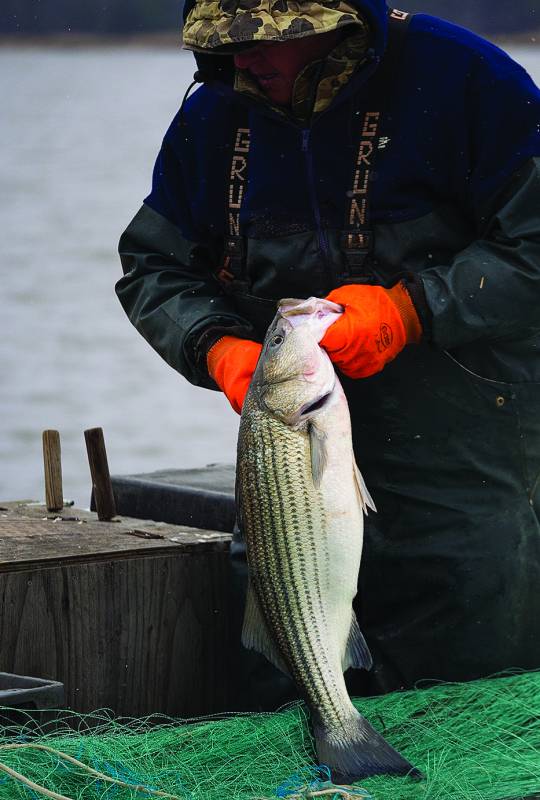 Striped bass, also known as rockfish, are one of the most popular sport and commercial fish in the Chesapeake Bay and along the mid-Atlantic coast. Their population has been in decline for at least a decade. (Dave Harp)
Striped bass, also known as rockfish, are one of the most popular sport and commercial fish in the Chesapeake Bay and along the mid-Atlantic coast. Their population has been in decline for at least a decade. (Dave Harp)Acting to stem serious declines in the striped bass population, East Coast fishery managers have ordered an 18% harvest reduction for the coming year. How that will be done in the Chesapeake Bay remains to be seen.
The Atlantic States Marine Fisheries Commission's striped bass management board on Wednesday agreed to the reduction after an extended debate over how to respond to a scientific assessment earlier this year that found the commercially and recreationally valuable species has been overfished for some time.
The board ordered an 18% cut in commercial harvest quotas in all East Coast states. It also called for comparable recreational catch restrictions. In coastal waters, anglers would be limited to just one fish per day between 28 and 35 inches in length, while in the Bay it would be just one fish per day at least 18 inches long. Anglers are allowed to keep two fish a day now in Maryland; Virginia has already reduced its limit from two to one.
Because the assessment found that many fish were dying after being caught and released, the board also ordered states to require that recreational anglers use circle hooks, which are less likely to injure the fish, beginning in 2021.
Striped bass, also known as rockfish, are one of the most popular sport and commercial fish in the Bay and along the mid-Atlantic coast, and that popularity has led to problems.
Overharvesting drove the population precariously low in the early 1980s, which prompted Maryland to impose a five-year fishing moratorium and other states to enact shorter bans. The fish rebounded, reaching a high abundance in the early 2000s.
But now striped bass have been declining for at least a decade, attributed in part to less successful reproduction. The assessment also found that millions of fish were dying after being released by recreational anglers, usually because they were too small to keep. The review estimated that more fish died after being discarded than were actually kept in 2017.
Commission members representing Maryland and the Potomac River Fisheries Commission argued unsuccessfully for a smaller commercial harvest reduction. The majority of all East Coast commercial striped bass landings come from the Chesapeake.
The board voted instead to require equal percentage reductions from both commercial and recreational fisheries, noting that public comments overwhelmingly favored that approach. Virginia sided with the majority.
But state fisheries managers also were given latitude to vary from the board's prescribed measures as long as they achieve "conservation equivalency," meaning that they achieve comparable reductions.
Maryland fishery managers are weighing that approach, with plans to propose changes that will result in a 20% reduction in mortality from the recreational fishery.
Michael Luisi, director of fisheries monitoring and assessment for the Department of Natural Resources, said managers are still looking to lighten the impact on the commercial fishery. "We just took 20.5 percent away five years ago from the commercial fishery," he said. "Now we're going to take another 18 percent away?"
Cuts of that size could put a commercial fisher out of business, Luisi suggested, while they wouldn't totally shut down someone who fishes for recreation. He also noted that commercial harvest only accounts for about 10% of the overall coastwide mortality of striped bass.
DNR officials also are looking at whether they can adjust recreational catch restrictions to ease the impact on the fishing charter industry. Luisi said that charter captains have warned they could be put out of business if each customer is only allowed to keep one striped bass per trip.
Luisi suggested that measures to curtail the deaths of discarded fish might count toward the interstate commission's goal of reducing the overall mortality rate.
DNR officials recently presented the department's fishery advisory commissions with a range of options they were considering. Whatever the DNR comes up with, Luisi said, likely will involve a combination of shortening the seasons (spring, summer and fall) and tightening size and catch restrictions.
While Virginia canceled its spring trophy season this year, Luisi said that Maryland is not considering such a move, though the trophy season might be shortened. "Our intent is not to eliminate anything, but to make some adjustments to the [fishing] effort that's applied in the different seasons," he said.
Besides shutting down its spring trophy season, the Virginia Marine Resources Commission adopted other emergency measures in August to reduce the state's striped bass catch. Those rules were made permanent in September. A VMRC spokeswoman said that state officials are evaluating what more, if anything, might be needed to comply with the interstate board's directions.
The Virginia commission reduced the recreational catch to one fish a day and raised the size limit from 28 to 36 inches, aiming to reduce the death of released fish. It also set gill net size limits for commercial fishers.
States must submit their plans for reducing harvest by Nov. 30, so they can be reviewed and acted on by the interstate commission by February. Changes are to take effect April 1, except for the circle hook requirement, which is delayed until Jan. 1, 2121.
Chris Moore, senior regional ecosystem scientist for the Chesapeake Bay Foundation, called the striped bass board's action an important step toward rebuilding the population coastwide. "All states in the region must now take meaningful action if we hope to see the iconic striped bass fishery once again rebound," he said.
Virginia has already taken "strong measures" by closing its spring trophy season and tightening fall catch limits, Moore said. "We now look for action from Maryland," he added, "which harvests approximately 34% of the total striped bass catch on the Atlantic Coast, to implement robust conservation measures for the 2020 fishing season."
Timothy B. Wheeler is associate editor and senior writer for the Bay Journal. He has more than two decades of experience covering the environment for The Baltimore Sun and other media outlets.


